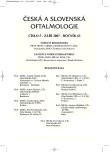Transcorneal and Transscleral Iontophoresis of the Dexamethasone Phosphate into the Rabbit Eye
Transkorneálna a transsklerálna ionoforéza dexametazón fosfátu do oka králika
Cieľ:
Vyhodnotiť účinnosť aplikácie dexametazón fosfátu do oka králika pomocou ionoforézy. Pre ionoforézu bol použitý prístroj „Mini Ion“ a hydrogélové nosiče z hydroxyetylmetakrylátu (HEMA) v zmesi s etylénglykoldimetakrylátom (EGMA).
Metóda:
Sledovala sa koncentrácia dexametazónu v rohovke králika bieleho po aplikácii tohoto farmaka pomocou transkorneálnej ionoforézy s intezitou prúdu 1 mAmp a dĺžkou aplikácie 60, 120 a 240 sekúnd. Kontrolnej skupine zvierat bol dexametazón aplikovaný formou očných kvapiek do spojivkového vaku. Ďalej sa sledovala koncentrácia liečiva v rôznych očných segmentoch po aplikácii transkonjunktiválnou a transsklerálnou ionoforézou. Pre posúdenie bezpečnosti aplikácie liečiv pomocou ionoforézy sme hodnotili histologické zmeny jednotlivých štruktúr rohovky 5 minút a 8 hodín po ukončení ionoforézy.
Výsledky:
Aplikácia dexametazón fosfátu ionoforézou vedie až k 38-krát vyššej koncentrácii liečiva v rohovke v porovnaní s koncentráciou dosiahnutou po aplikácii očných kvapiek do spojivkového vaku. Rozdiel v koncentrácii farmaka v prednom, ako aj v zadnom segmente pri transkonjunktivalnej a transsklerálnej aplikácii nie je štatisticky signifikantný. Pre dosiahnutie vysokej koncentrácie liečiva v sietnici nie je teda nutné odpreparovať spojivku. Histologická analýza rohoviek po ionoforetickej aplikácii farmaka s intenzitou prúdu 0,5 mAmp odhalila bezprostredne po aplikácii iba minimálne defekty epitelu a mierny edém strómy rohovky, ktoré v priebehu 8 hodín spontánne regredovali.
Záver:
Výsledky štúdie potvrdili, že aplikácia liečiv pomocou ionoforézy je efektívnou a bezpečnou metódou, pomocou ktorej je možné dosiahnuť vysoké koncentrácie farmaka v rohovke ako aj v zadnom očnom segmente.
Kľúčové slová:
ionoforéza, hydrogél, dexametazón fosfát, koncentrácia farmaka, toxicita
Authors:
F. Raiskup-Wolf 1; E. Eljarrat-Binstock 2; M. Rehák 3; A. Domb 2; J. Frucht-Pery 4
Authors‘ workplace:
Očná klinika, Fakultná nemocnica Univerzity Drážďany, Nemecko
prednosta prof. Dr. med. Lutz E. Pillunat
1; Oddelenie lekárskej chémie a prírodných výrobkov, Lekárska fakulta
Hebrejská univerzita, Jeruzalem, Izrael
prednosta prof. Avi Domb, PhD.
2; Očná klinika, Fakultná nemocnica Univerzity Lipsko, Nemecko
prednosta prof. Dr. med. Peter Wiedemann
3; Očná klinika, Fakultná nemocnica Hadassah, Jeruzalem, Izrael
prednosta prof. Jacob Pe`er, M. D.
4
Published in:
Čes. a slov. Oftal., 63, 2007, No. 5, p. 360-368
Overview
Purpose:
To evaluate the efficiency of the dexamethasone phosphate penetration into the rabbit eye after transcorneal and transscleral iontophoresis using a drug loaded hydrogel assembled on a portable iontophoretic Mini Ion device.
Methods:
Iontophoresis of dexamethasone phosphate was studied in healthy rabbits using drug-loaded disposable HEMA hydrogel sponges and portable iontophoretic device. Corneal iontophoretic administration was performed with electric current of 1 mAmp for 1, 2, and 4 min. In the control group, the dexamethasone was applied in drops into the conjunctival sac. Transconjunctival and transscleral iontophoresis were performed in the pars plana area, through the conjunctiva or directly on the sclera. Dexamethasone concentrations were assayed using HPLC method. To study the anatomical changes after iontophoresis application, histological examinations of corneas excised 5 minutes and 8 hours after the procedure were performed.
Results:
Dexamethasone levels in the rabbits’ corneas after a single transcorneal iontophoresis were up to 38 times higher compared to those obtained after topical eye drops instillation. High drug concentrations were obtained in the retina and sclera 4 hours after transscleral iontophoresis as well. There were no statistically significant differences in the drug concentration after transscleral and tranconjunctival iontophoresis. Histological examination of the corneas after the iontophoresis showed only discrete reversible changes of the epithelium and the stroma.
Conclusion:
A short, low-current, non-invasive iontophoretic treatment using the dexamethasone-loaded hydrogels has a potential clinical value in increasing the drug’s penetration into the anterior and posterior segment of the eye.
Key words:
iontophoresis, hydrogels, dexamethasone phosphate, concentration of the drug, toxicity
Labels
OphthalmologyArticle was published in
Czech and Slovak Ophthalmology

2007 Issue 5
Most read in this issue
- The Importance of HRT II and Perimeter Octopus 101 in Glaucoma Diseases
- Importance of Structural Examination Methods in the Follow-up of Patients with Ocular Hypertension
- Transcorneal and Transscleral Iontophoresis of the Dexamethasone Phosphate into the Rabbit Eye
- The Treatment of the Exsudative Age-Related Macular Degeneration with Choroidal Neovascular Membrane, its Possibilities and Economical Indexes
